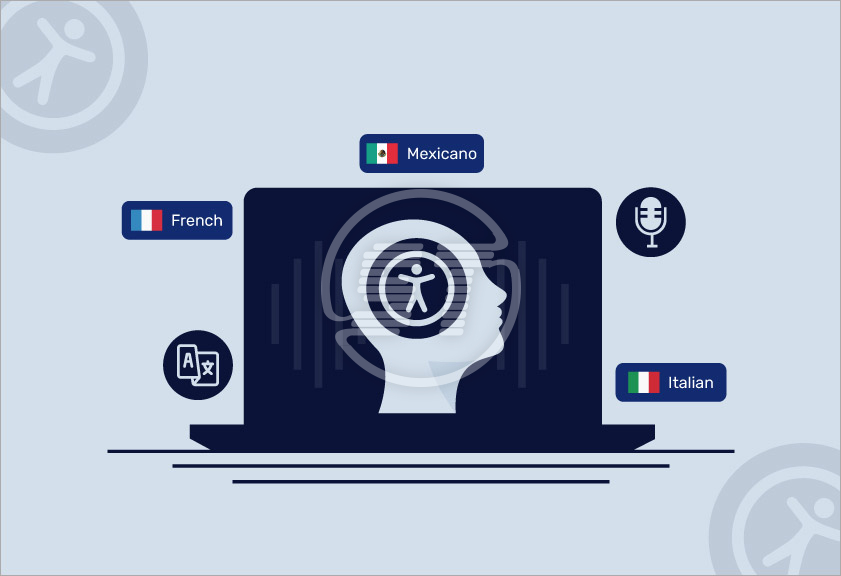When considering digital accessibility, visual or motor disabilities are often the first to come to mind. However, speech and language disabilities also play a major role in how users interact with digital environments. These disabilities can affect a person’s ability to communicate, comprehend, or use online tools that rely on voice input or text-based instructions. For brands and developers aiming to create truly inclusive digital experiences, understanding and addressing these challenges is essential.
Understanding speech and language disabilities
Speech and language disabilities encompass a wide range of conditions that impact how people understand, express, or produce language. Some common examples include:
- Aphasia: Difficulty in understanding or forming language, often due to brain injury or stroke.
- Dysarthria: Slurred or slow speech caused by muscle weakness.
- Stuttering (stammering): Repetitions or prolongations in speech sounds that affect fluency.
- Apraxia of speech: Difficulty in coordinating mouth and speech movements.
- Language processing disorders: Challenges in understanding or interpreting spoken and written language.
These conditions can vary in severity and may coexist with other cognitive or physical disabilities. Online platforms that heavily rely on voice commands, written instructions, or rapid response interfaces can become barriers for such users.
Impact on online experiences
- Voice-based navigation challenges
Voice assistants, chatbots, and voice search have become increasingly common in digital interfaces. However, users with speech impairments may struggle to interact effectively with these tools. Misrecognition by speech recognition systems can lead to frustration and exclusion.
- Difficulty with text-heavy content
Websites that rely on complex language, jargon, or long paragraphs can overwhelm users with language comprehension difficulties. Inaccessible content structures and a lack of plain language options make it harder to understand key information.
- Limited accessibility in online forms and captchas
Online forms that require written input or spoken verification can pose serious barriers. For example, a speech-based CAPTCHA or form validation that depends on verbal confirmation excludes users with speech issues.
- Exclusion in real-time communication tools
Virtual meetings, live chats, and customer support calls often depend on verbal communication. Without captioning, text chat alternatives, or easy-to-use assistive tools, users with speech or language disabilities may find it impossible to participate equally.
- Inaccessible learning platforms
E-learning platforms often require reading comprehension, verbal responses, or participation in group discussions. Without accommodations like transcripts, simplified text, or alternative input methods, learners with these disabilities face major hurdles.
How to address these barriers – crucial to know!
Creating accessible digital experiences for users with speech and language disabilities involves thoughtful design, inclusive technology, and adherence to accessibility standards like WCAG 2.2 and EAA (European Accessibility Act).
- Provide multiple input and output options
- Offer keyboard, text, or visual alternatives to voice-based navigation.
- Ensure that voice assistants or chatbots support typed input.
- Integrate symbol-based or predictive text tools for easier interaction.
- Use plain language and clear communication
- Simplify text with short sentences, familiar words, and logical flow.
- Add visual cues, icons, or illustrations to support understanding.
- Provide summaries or “easy-read” versions for complex content.
- Offer real-time text and captioning options
- Include live captioning and speech-to-text features in meetings, webinars, and video calls.
- Ensure chat-based alternatives are available in customer service or help desks.
- Enhance comprehension with multimedia support
- Add audio versions, transcripts, or sign language videos where applicable.
- Use interactive content that allows users to control pacing and navigation.
- Design inclusive CAPTCHAs and forms
- Replace audio or speech-based CAPTCHA with visual puzzles or reCAPTCHA v3, which assesses behaviour instead of requiring user input.
- Support autofill and predictive text to reduce typing effort.
- Test with users with speech and language disabilities
- Conduct usability testing that includes individuals with varied communication abilities.
- Use assistive technology compatibility checks, like screen readers and speech-to-text tools, to ensure smooth interaction.
Best practices for web and app developers
- Follow WCAG 2.2 guidelines, especially success criteria related to understandable content and input modalities.
- Implement ARIA (Accessible Rich Internet Applications) attributes to make dynamic content easier to interpret.
- Use AI-based accessibility tools like All in One Accessibility® that can detect complex language or missing alternative inputs. It supports 140+ languages, even screen reader can speak in your preferred voice and language.
- Train content teams to write accessible and inclusive content, keeping readability levels in mind.
Also read: EAA Compliant Website Accessibility Statement
In a nutshell,
Speech and language disabilities may be less visible, but they profoundly impact digital inclusion. Addressing these challenges requires empathy, design awareness, and the integration of assistive features that empower all users to communicate, learn, and navigate freely online.
By combining technology with human-centered design, we can ensure that online experiences are not just functional - but truly inclusive for every voice, spoken or unspoken.
At Skynet Technologies, we specialize in creating inclusive digital experiences that empower individuals with speech and language disorders to navigate online platforms with ease. From accessibility audit and multi-language website accessibility remediation services to custom accessibility widget integration and VPAT / ACR, our team helps businesses design websites that comply with WCAG standards and deliver seamless usability for all. Reach out [email protected] to improve digital presence more inclusive, accessible, and compliant.
